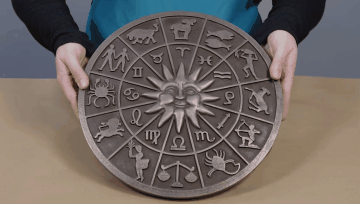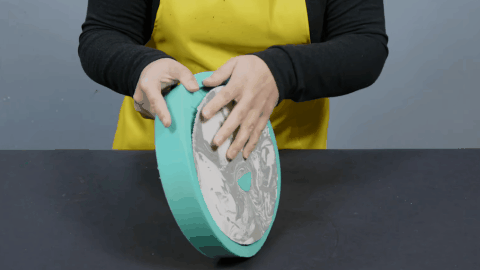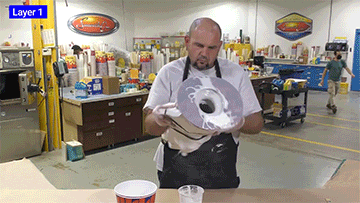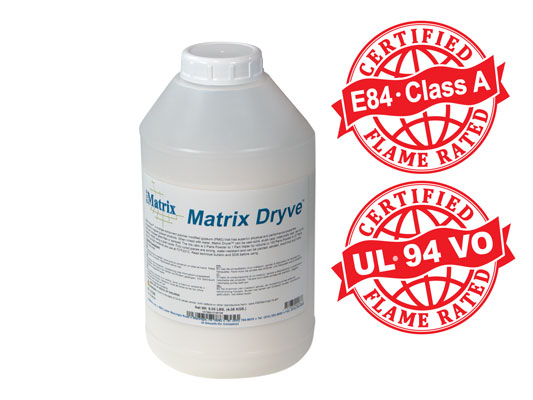Matrix Dryve™
Matrix Dryve™ is a versatile all-powder polymer modified gypsum system that has superior physical and performance properties compared to regular gypsum products. It is an “all-powder” alternative to our original Matrix™ NEO powder/liquid system.
Features
The mix ratio of Dryve™ is 3 parts Dryve™ powder to 1 part water by volume (100 parts Dryve™ powder to 27 parts water by weight). Dryve™ is easy to use and can be cast solid, slush cast, rotationally cast, laid up by hand with chopped glass fiber or sprayed. Dryve™ can be thickened using Matrix™ Thickener, accelerated using Matrix™ Accelerator and slowed using Matrix™ Retarder. Fully cured pieces are strong, water-resistant and can be painted, sanded, machined and more.
Dryve™ certifies to the highest flame rating (UL-94V-O / ASTM E-84 - Class A), making it suitable for public space applications including creating themed environment elements, architectural elements, sculpture and more.
Versatility – Dryve™ can take you in many creative directions by allowing you to make a variety of finish effects including different colors, metallics, glitters, stone and more.
Click Here To Learn How To Color Matrix™ Dryve
Click Here To Learn How To Metal Cold Cast and More with Matrix™ Dryve
Instructions
Safety - Store and use material at room temperature (73°F/23°C). These products have a limited shelf life and should be used as soon as possible. Colder temperatures will slow the working/cure time, while warmer temperatures will reduce working times. Store individual components in a dry environment at room temperature. Wear safety glasses, long sleeves and rubber gloves to minimize contamination risk. Mixing containers should have straight sides and a flat bottom.
Applying A Release Agent - A release agent is necessary to facilitate demolding when casting into urethane rubber molds. Use a release agent made specifically for mold making (Ease Release™ 2831 or Sonite™ Wax available from Smooth-On or your Smooth-On distributor). Release agent should be applied onto all mold surfaces that will contact the Dryve™.
Because no two applications are quite the same, a small test application to determine suitability for your project is recommended if performance of this material is in question.
MEASURING & MIXING...
Use Power Drill & Mechanical Mixer to Mix - Best results are obtained when powder and water is mixed using a variable speed power drill (set on high) with a mechanical mixer attachment such as a Turbine Mixer or Jiffy Mixer. You will need several measuring containers and larger mixing containers. To minimize dust inhalation, we recommend that you wear a NIOSH approved dust mask while dispensing and mixing components.
Mix ratio: 3 parts Dryve™ powder to 1 part water by volume (100 parts Dryve™ powder to 27 parts water by weight).
Step 1: Dispense required amount of room temperature (73°F/23°C) water into large mixing container.
Step 2: Dispense required amount of Dryve™ powder into measuring container. With power mixer set on low at bottom of mixing container, gradually sift powder contents into water.
Step 3 - Drill Mixing: Drill mix components with power drill set on high. Be careful not to splash material. Pot life when drill mixing will be about 20 minutes at room temperature (73°F/23°C) depending on mass and configuration. Drill mix until dry powder is thoroughly dispersed into water (1 – 2 minutes) and lumps disappear to a creamy consistency. Do not mix more than 2 minutes. The longer you drill mix, the shorter your pot life will be.
After thorough mixing, Dryve™ is ready to be poured.
Pouring...
Pour your mixture in a single spot at the lowest point of the containment field and let the mixture seek its level. This will help minimize air entrapment.
Air bubbles are sometimes a concern with polymer modified gypsums and will vary depending on conditions. There are additional steps you can take to help reduce entrapped air:
1. Vacuuming Material – Required: vacuum chamber and vacuum pump. Prior to pouring material into mold, place mixing vessel in vacuum chamber and subject mixture to 29 hg vacuum for 1 minute. Mixture will bubble, rise, break and fall. After mixture falls, remove from chamber and pour into mold.
2. Pressure – Required: pressure vessel and compressor. After mixture is poured into mold, place mold in a pressure vessel and subject mixture to 60 PSI (4.2 kg/cm2) air pressure for one hour.
HAND LAY-UP TECHNIQUE...
This product can be used to make interior and exterior architectural elements and rigid support shells to reinforce brush on rubber molds. With the addition of glass fibers in the form of fiberglass matting or chopped fibers, Dryve™ can be “layed up” to make elements that are thin, lightweight and exceptionally strong.
For exterior use, applying a sealer or painting the finished casting is recommended. Chopped fiberglass (such as Matrix™ Chopped Glass available from Smooth-On or your Smooth-On distributor) is most commonly used for this application.
Chop strand mat (3/4 ounce or 22 gram available at a fiberglass supply house) is most commonly used for making large architectural panels.
Hand Lay Up Using Fiberglass Matting - Mix Dryve™ and brush a surface or “gel” coat into a mold. Let cure 10-15 minutes or until Dryve™ gels. Mix another batch and dip fiberglass matting into liquid. Squeeze out excess and lay over previous layer.
After a uniform coating is attained, apply another layer of matting and brush again. Apply a minimal amount of Dryve™—just enough to wet out the surface. Repeat as necessary until 3/8” (1 cm) thickness is attained. The composite mixture over the face mix should have a minimum thickness of 3/8” (1 cm) and contain 5%–10% glass fiber reinforcement.
Hand Lay Up Technique Using Chopped Glass - Another technique for making strong, lightweight elements is to mix chopped fiber directly into the Dryve™ standard mix. Generally, 3/4” “AR” grade chopped fiber works best. “E” grade can also be used. Adding chopped fiber takes much less time than layering fiberglass matting.
How To Proceed...An accurate gram scale to weigh components is necessary. The chopped fiber is added as a percentage of the total weight. Fiber can be added in concentrations of 3% to 12%. For best results, 6% chopped fiber should be added. Mix Dryve™ and brush a surface or “gel” coat into mold. Let cure 10-15 minutes or until material gels.
Next, weigh out 100 Parts of Dryve™ powder, 27 Parts of water and 8 parts of chopped fiber. Mix all parts thoroughly and apply mixture with gloved hand or spatula over gel coat. Additional applications may be required to attain 3/8” (1 cm) thickness.
CREATING FINISHED EFFECTS
Dryve™ can be colored by adding Buddy Rhodes Pure Collection™ powder pigments.
Visit smooth-on.com/dryvecolors for color examples. We recommend using a 100 parts Dryve™ powder to 35 parts water by weight mix ratio when adding Pure Collection™ pigments.
Metal powders (bronze, pewter, brass, etc.) can be added to give the look of real metal castings at a fraction of the cost. Casting effects are also possible using Cast Magic™ powders.
You can create marbling and other effects using inexpensive fillers and pigments. Stone effects can be achieved using Quarry Tone™ stone effects powders.
Create long lasting glow in the dark effects by adding Glow Worm™ glow powder.
See separate TB at smooth-on.com/dryveeffects for more information on coloring and adding fillers and powders to Dryve™ to create casting effects.
ACCELERATING DRYVE™ WITH MATRIX™ ACCELERATOR
Matrix™ Accelerator Powder mixed with water can be added at different percentages to change the pot life and demold time of Dryve™. This can be helpful with hand lay-up, rotocasting and slush casting techniques.
Step 1: Add 80 g of Matrix™ Accelerator to 480 g of room temperature water to create a solution. Mix until powder is fully dissolved. This can be stored for future use. Accelerator solution must be pre-mixed before using after storage.
Step 2: Mix Dryve™ powder and water together until powder is fully integrated, about 1 min.
Step 3: Add Accelerator solution while mixing.
Step 4: Continue to drill mix for another 30 seconds. Important: Excessive mixing can shorten the pot life.
| Dryve™ Powder | Water | Matrix™ Accelerator (% of powder by weight) | Pot Life | Demold Time |
|---|---|---|---|---|
| 100 | 27 | 0.5 Part (0.5% of powder by weight) | 12 min. | 60 min. |
| 100 | 27 | 1.0 Part (1.0% of powder by weight) | 10 min. | 50 min. |
| 100 | 27 | 1.5 Parts (1.5% of powder by weight) | 8 min. | 45 min. |
SLOWING DRYVE™ WITH MATRIX™ RETARDER
You can extend the working time of Dryve™ by adding a very small amount of Matrix™ Retarder to the mix.
Step 1: Add 5 g of Matrix™ Retarder to 240 g of room temperature water to create a solution. Mix until powder is fully dissolved. This can be stored for future use. Retarder solution must be pre-mixed before using after storage.
Step 2: Mix Dryve™ powder and water together until powder is fully integrated, about 1 min.
Step 3: Add Retarder solution while mixing.
Step 4: Continue to drill mix for another 30 seconds. Important: Excessive mixing can shorten the pot life.
| Dryve™ Powder | Water | Matrix™ Retarder (% of powder by weight) | Pot Life | Demold Time |
|---|---|---|---|---|
| 100 | 27 | 2 Parts (2% of powder by weight) | 60 min. | 120 min. |
| 100 | 27 | 4 Parts (4% of powder by weight) | 105 min. | 150 min. |
THICKENING DRYVE™ USING MATRIX™ THICKENER
Increase the viscosity of Matrix Dryve™ by adding a small amount of Matrix™ Thickener to your mix. This will give you better control over the viscosity of your mix and help reduce the number of layers needed when using Dryve™ for hand lay-up, rotocasting or slush casting applications.
Measuring by Weight: Using an accurate gram scale, weigh out 100 Parts of Dryve™ powder. Matrix™ Thickener is then measured out as a percentage of Dryve™ powder; reference chart below for consistency. Add Thickener after Dryve™ powder and water are thoroughly mixed. Continue to mix for about 15 more seconds.
| Dryve™ Powder | Water | Thickener (% of Part B by weight) | Pot Life | Cure Time | Consistency |
|---|---|---|---|---|---|
| 100 | 27 | 0.5 Part (.5% of powder by weight) | 30 min. | 70 min. | Thick |
| 100 | 27 | 1 Part (1% of powder by weight) | 40 min. | 90 min. | Thicker |
| 100 | 27 | 1.5 Parts (1.5% of powder by weight) | 80 min. | 190 min. | Thickest |
Important: Do not exceed 1.5 Parts of Thickener. Overloading the material will thin it back out.
ROTOCASTING DRYVE™
Matrix Dryve™ is ideal for rotational casting applications to create hollow, lightweight castings. Dryve™ can be rotationally cast either by hand or by machine. A minimum of 4 successive layers will build an adequate final thickness for strength and handle-ability (3/8” or 1 cm). The first layer is unthickened. To build interior wall thickness quickly, a small amount of Matrix™ Thickener (1.5% of powder by weight) can be added to your mix. Matrix™ Thickener slows the pot life and cure time of Dryve™. You can counteract this by adding Matrix™ Accelerator.
Adding Thickener And Accelerator: Using an accurate gram scale, weigh out 100 Parts of Dryve™ powder. Matrix™ Thickener and Matrix ™ Accelerator solution are then measured out as a percentage of Dryve™ powder; reference chart below for pot life and cure time. Mix Dryve™ powder and water together until powder is fully integrated, about 1 minute. Add Accelerator solution while mixing. Add Thickener after Dryve™ powder and water are thoroughly mixed. Continue to mix for about 15 more seconds. Pour Dryve™ into prepared mold and rotate the mold until mixture sets up (partially cures).
| Dryve™ Powder | Water | Thickener (% of Part B by weight) | Matrix™ Accelerator (% of powder by weight) | Pot Life | Cure Time |
|---|---|---|---|---|---|
| 100 | 27 | 1.5 Parts (1.5% of powder by weight) | 1.5 Parts (1.5% of powder by weight) | 10 min. | 75 min. |
| 100 | 27 | 1.5 Parts (1.5% of powder by weight) | 4 Parts (1.5% of powder by weight) | 8 min. | 50 min. |
| 100 | 27 | 1.5 Parts (1.5% of powder by weight) | 7 Parts (1.5% of powder by weight) | 4 min. | 45 min. |
Important: Do not exceed 7 Parts of Accelerator. Overloading the material will thin it back out.
Option: Additional unthickened Dryve™ can be combined with Matrix™ glass to provide additional strength to the third layer layers. Add up to 6% Matrix™ Glass by weight of powder to create a reinforced, flowing mixture.
SURFACE PREPARATION FOR SEALING OR PAINTING...
Dryve™ castings must be allowed 24 hours of drying in an environment with less than 50% humidity prior to painting. After drying for 24 hours, release agents must be removed from castings, otherwise paint will not stick.
To remove Ease Release™ 2831 or Sonite™ Wax from a Dryve™ casting, a cleaning solution of 10 Parts warm water (120°F / 49°C) and 1 Part dishwashing detergent should be used. Using a soft nylon brush, scrub over the entire piece two to three times making sure to get into all the surface detail. Remove soap solution from castings by rinsing under warm water and allow them to air dry before sealing or painting.
For Exterior Use, Apply A Sealer - Because the Dryve™ system substantially reduces the water absorption rate (0.25%) of alpha gypsums, elements made with Dryve™ are suitable for exterior use. However, Dryve™ castings must be sealed with a suitable siloxane sealer or concrete / masonry sealer such as Euclid Chemical Baracade Silane 40 WB or Baracade Silane 100 C. Castings can also be painted with an outdoor acrylic sealer or paint.
Related Categories: Flame Rated Materials, Polymer Modifiers for Concrete and Gypsum
Related Series: duoMatrix™ Gypsum Systems – Polymer Modified Gypsums, Flame Rated Materials – Protecting Public Spaces
How-To Articles

How To Make a Metal Cold Casting Using Matrix Dryve™ Polymer Gypsum
Learn how you can cold cast Matrix Dryve™ polymer gypsum

How To Create a Marble Effect In Castings Using Matrix Dryve™
We demonstrate how you can use Matrix Dryve™ to create interesting marbling effects.

Making a Lightweight, Strong, Hollow Casting by Rotocasting Matrix Dryve™
Milo shows how to rotocast Matrix™ Dryve™ polymer gypsum
